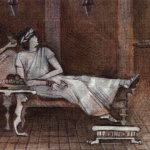Through the ages, physicians have been at the warrior’s side, offering rudimentary forms of first aid medicine. Admiral Horatio Lord Nelson, a British naval commander, is credited with promoting a revolution in disease control in the military, perhaps due to his personal lengthy list of medical maladies, including yellow fever, and the loss of one eye and an arm.4 Sadly, since Nelson’s time, there have been countless opportunities for physicians and surgeons to hone their battlefield skills.
Death by Infection
Until WWI, most wartime casualties were caused by infections. The lack of proper antisepsis guaranteed that even the most trivial battlefield injury could become fatal. Poor sanitation, cramped living spaces and malnutrition promoted transmission of infectious disease vectors. Cholera, typhoid, streptococcus and a host of enteric bacteria preyed on their hosts’ weakened immune systems. Diarrhea, dysentery and rheumatic fever were among the most prevalent medical problems throughout the American Civil War—and probably throughout all wars up to that time. Not all of the afflicted died. In fact, many survived, and some of them experienced what we now consider to be forms of reactive arthritis. For example, with more than 2 million cases of diarrheal illnesses and 100,000 cases of urethritis reported, it is estimated that there may have been about 30,000 cases of reactive arthritis among the Union troops.5
Bacteria don’t choose sides in war; they are equal-opportunity infectors. In 1864, Confederate Army General Robert E. Lee contracted a throat infection,“which settled into inflammation of the pericardium.”5 He subsequently complained of chronic joint and back pain. Whether this pain was a manifestation of a post-streptococcal arthritis is not clear, but it affected his ability to lead his army and may have indirectly influenced the outcome of a major battle.
During May 1864, following a bloody conflict against the Army of the Potomac near Chancellorsville, Va., Lee was in so much pain from his “rheumatism” that he allowed himself to be taken for a brief reconnaissance mission in a carriage, rather than riding horseback. He realized that his adversary, General Ulysses Grant, had been forced to split his troops, making them vulnerable to counterattack by Confederate forces. But this opportunity began to fade as the Union battalions entrenched while Lee’s illness worsened and he became bedridden. He could not be afield to direct affairs himself, and, as timing would have it, several of his senior commanders fell ill with similar symptoms. Lacking leadership, the Confederate Army lost a precious opportunity to bisect the Union forces.5



